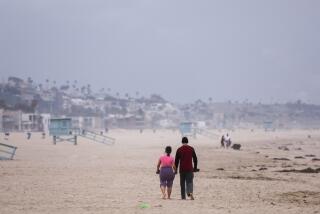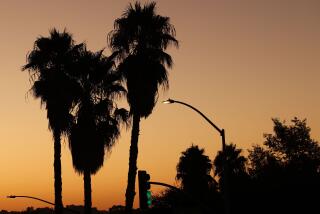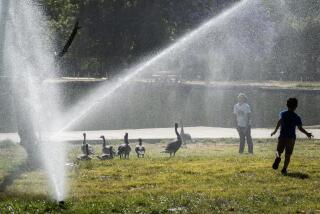A Little Taste of the Tropics Starts Southland’s Week
- Share via
If it seemed to you like uncommonly nice weather around here on Monday, you were wrong.
According to the people who study such things, those balmy temperatures and relatively blue skies are pretty typical in the Los Angeles area at this time of year.
Take the high temperature at the Civic Center on Monday--84 degrees.
According to the National Weather Service, that’s the normal high for the date. Monday’s overnight low--68 degrees--was only two degrees above the norm.
The maximum and minimum humidity readings--79% and 34%--are not that unusual either, according to meteorologists.
And the folks over at the Air Quality Management District say the smog readings were pretty typical too.
So why did it seem so pleasant?
There are a couple of possible reasons, the experts say.
Subtropical Air
A large high-pressure system has been pumping moist subtropical air into Southern California from Mexico, according to the people at WeatherData Inc., the private meteorological service that provides forecasts for The Times. They said it is the sort of situation that occurs fairly often around here in August.
This subtropical moisture has meant scattered high clouds and haze that have blocked a lot of the direct sunlight, reducing the scorching effect often felt from exposure to the sun.
While the maximum humidity readings are not abnormal, they result from this subtropical air, rather than from the more familiar overnight incursion of marine air from the Pacific. This subtropical humidity, felt during the middle of the day, can give the weather a “soft” feel if the temperatures are not too high.
As for the bluer skies, that is probably due, in part, to a relatively weak inversion layer, again prompted by the subtropical air, according to Claudia Keith at the AQMD.
“But just because it doesn’t look smoggy, that doesn’t mean it’s not smoggy,” she said.
Invisible Ozone
Keith explained that, under these weather conditions, the brown haze of nitrogen dioxide can disperse quickly into ozone, which is colorless and invisible to the eye. And ozone, which irritates and impairs breathing, “is the worst component of smog, the one we’re most concerned with,” she said.
According to WeatherData’s Rick Dittmann, the weather could get a lot more dramatic--and less pleasant--in a hurry.
He said the subtropical moisture was creating thunderstorms in the inland desert areas that could cause serious flash-flooding in some areas. And some of these thunderstorms, which were straying into the San Gabriel Mountains above Los Angeles late Monday, could spill over into the San Gabriel, San Fernando and San Bernardino valleys.
And Dittmann said temperatures should be a little warmer today, in the upper 80s and low 90s.
That’s probably enough, he said, to convert that nice, “soft” feel into plain, old “sticky.”
More to Read
Sign up for Essential California
The most important California stories and recommendations in your inbox every morning.
You may occasionally receive promotional content from the Los Angeles Times.










